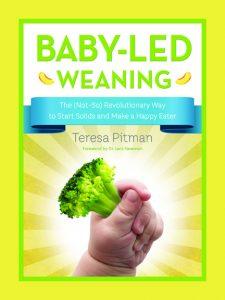
Solid points for when to introduce solids
By Teresa Pitman
By the early to mid-1940s, doctors were recommending that formula-feeding parents should be adding solid foods earlier and earlier. (In time, they began to recommend this to breastfeeding parents as well, though there was no evidence to support this advice.) After the end of World War II, 6 weeks had become the standard age, and that advice continued for several decades. However, some doctors encouraged parents to start even earlier, sometimes within a week of the baby being born.
Parents often didn’t need a lot of encouragement — many saw starting solids as a developmental milestone. It also was seen as helpful if the mother was breastfeeding, because she could take a break from the baby if she wanted to without having to provide bottles.
Blue-Ribbon Babies
The mid-1900s was also a time when the chubby baby was seen as ideal. Every mother wanted a “blue-ribbon” baby, and solid foods could be used to fatten up the baby who wasn’t plump enough. Some mothers were even given booklets recommending fudge as the ideal food to fatten up a skinny baby. But too-rapid weight gain in infancy has since been linked to childhood and adult obesity, a significant problem in North America, where nearly one-third of adults are obese and the associated health problems are becoming an epidemic.
It’s important to note that some breastfed babies do gain weight quickly in the first few months and can become very chubby. This normally resolves itself once the baby becomes mobile, in the second half of the first year, and the baby typically develops to a normal weight as a toddler. This is not the same situation as the baby who has been overfed on other foods.
These recommendations for introducing infant cereal and other foods early in life were not supported by research. Although many physicians were encouraging solids in the first couple of months after birth, research continued to indicate that starting solids later was associated with healthier babies and children, especially if the babies were breastfed.
To confirm this, the World Health Organization (WHO) reviewed the research and conducted its own studies involving thousands of babies from around the world. In 2003, the WHO issued a report entitled Complementary Feeding: Report of the Global Consultation that recommended exclusive breastfeeding from birth, introducing solids at around 6 months and continuing breastfeeding for two years and beyond. Why does the WHO advise waiting for six months to start offering solid foods? Because there are some real risks to adding foods other than human milk to a baby’s diet too early.
Infections and Diseases
You probably know that exclusive breastfeeding reduces a baby’s risk of catching various infections and diseases, including gastrointestinal illnesses (such as diarrheal disease), respiratory illnesses (such as influenza and pneumonia) and other illnesses (such as meningitis and ear infections). How does human milk do this? It contains several protective mechanisms.
One such mechanism is the secretory immunoglobulin A antibody. It coats the lining of the baby’s entire digestive tract and helps to prevent bacteria and other microbes from getting into the baby’s system and causing an infection. It even gets into the baby’s nose at times when he sneezes milk or spits up — again, preventing bacteria from getting into his system through that avenue.
While keeping out the bad bacteria, human milk also provides food for the good bacteria. All of us have some good bacteria in our intestines that help us digest food, among other things. (The bacteria found in the intestinal tract are collectively known as gut flora.) We have learned in recent years that these bacteria play much more complex roles in our lives. For example, they influence our food choices, the development of our immune systems when we’re babies and the expression of our genes.
The types of bacteria present depend on our diet and other factors — taking antibiotics can wipe out a large number of the health-promoting good bacteria, for example. Breastfed babies have more of the protective bacteria than those fed formula, and these good bacteria fight any bad bacteria that get into the system and potentially cause disease.
When solid foods are added to a breastfed baby’s diet, the bacterial balance in the baby’s gut is disrupted. That makes the baby more vulnerable to infections, which can have serious consequences in some cases, especially when the baby is too young to have his own strong immune system. In fact, the WHO research showed that babies who started solids earlier had more infections. Even a mild infection can mean that the baby gets treated with antibiotics, which causes more changes to the baby’s gut flora and leads to higher risks of health problems later.
For example, a 2017 study led by Dr. Rebecca Slykerman found that being given antibiotics in infancy increased a person’s risk of depression and behavioral problems in childhood (ages 7 to 11 years). In 2016, research studies in the UK, the U.S. and Finland all pointed to increased weight gain among children who had been given antibiotics in infancy. (Farmers who raise animals for meat, such as chickens, cows and pigs, have long known that antibiotic use increases the rate of weight gain.)
So maintaining a baby on human milk as long as possible is important not only for that baby’s immediate health, but also for his future health. As the baby gets older, his own immune system will start ramping up, and after six months or so, the negative effects of solid foods are less significant.
Human Milk Production
Starting solids too early can also displace human milk. Why does this matter? Every mammal species has a normal duration of lactation. For some, like dogs, it’s measured in weeks. For primates — and humans are primates — the normal duration is usually two or more years. Research by anthropologist Kathy Dettwyler suggests that the normal age for ending breastfeeding in humans is between 30 months and 7 years.
But a lactating mother’s ability to produce milk depends on that milk being removed from her body on a regular basis, and she is more sensitive to a decrease in milk removal when the baby is younger. If a baby starts solids at three months and is fed a significant amount of solid food, then the baby will be taking less breast milk and the mother’s milk supply is likely to decrease. As this continues, it can lead to breastfeeding ending too early — and the baby misses out on the important antibodies and nutrition that continued breastfeeding would have provided.
Obesity
Finally, too-early solids are linked to excess weight and obesity. When babies are spoon-fed, it’s easy for a parent to give the baby more than he wants. If the food is fairly liquid, such as a puree, it can trigger the swallowing reflex once it’s in the baby’s mouth, even if he really would rather spit it out. Parents also have a natural tendency to want to finish up the food in the bowl: if the baby seems uninterested but there is just a spoonful or two left, parents may want to spoon in those last bits of cereal or sweet potato. For a small baby, though, that extra food can be setting a lifelong pattern of eating beyond when he feels full.
So waiting until the baby is ready for solid foods, usually at around six months, has many important benefits.
 – Baby-Led Weaning: The (Not-So) Revolutionary Way to Start Solids and Make a Happy Eater by Teresa Pitman – Published by Firefly Books Ltd. / Copyright © 2018 Firefly Books Ltd.
– Baby-Led Weaning: The (Not-So) Revolutionary Way to Start Solids and Make a Happy Eater by Teresa Pitman – Published by Firefly Books Ltd. / Copyright © 2018 Firefly Books Ltd.







